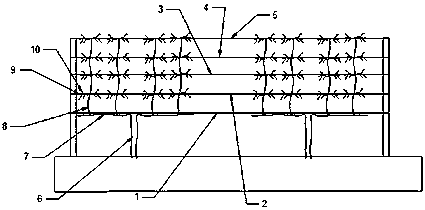Shaping and pruning method for plum trees and apricot trees
A technology for shaping and pruning apricot trees, applied in gardening methods, botanical equipment and methods, gardening, etc., can solve problems such as limited yield, and achieve the effects of increasing yield, reducing row spacing, and avoiding aging of fruit branches.
- Summary
- Abstract
- Description
- Claims
- Application Information
AI Technical Summary
Problems solved by technology
Method used
Image
Examples
Embodiment 1
[0050] refer to figure 1 :
[0051] The growth period of the first year: the seedlings are planted in autumn or early spring, the row spacing of the seedlings is 1.5m, and then the position with full buds on the left and right sides is selected within 45cm from the ground; 6. Choose to keep one robust new shoot on each of the left and right sides, and erase the rest; then let the two branches grow upright until the length exceeds 2m, and then carry out continuous topping; after the branches stop growing in autumn, remove the The two large branches are horizontally fixed to the first baseline 1 by pulling the branches, and are distributed on the left and right sides of the main trunk 6 as the primary main branch 7;
[0052] The dormant period of the first year: the branches on the two first-level main branches 7 are selected and pruned, all the branches facing the ground are removed from the base, and the branches growing on both sides are kept if the thickness is less than 61...
Embodiment 2
[0063] refer to figure 1 :
[0064] The growth period of the first year: the seedlings are planted in autumn or early spring, and the row spacing of the seedlings is 2m, and then select the positions with full buds on the left and right sides within 55cm from the ground; Choose to keep one robust new shoot on the left and right sides, and remove the remaining shoots; then let the two branches grow upright until the length exceeds 2m, and then carry out continuous topping; after the branches stop growing in autumn, remove the two branches. A large branch is horizontally fixed to the first baseline 1 by pulling the branches, and is distributed on the left and right sides of the main trunk 6 as the first-level main branch 7;
[0065] The dormant period of the first year: the branches on the two first-level main branches 7 are selected and pruned, all the branches facing the ground are removed from the base, and the branches growing on both sides are kept if the thickness is less...
Embodiment 3
[0076] refer to figure 1 :
[0077] The growth period of the first year: the seedlings are planted in autumn or early spring, the row spacing of the seedlings is 1.8m, and then the position with full buds on the left and right sides is selected within 50cm from the ground; 6. Choose to keep one robust new shoot on each of the left and right sides, and erase the rest; then let the two branches grow upright until the length exceeds 2m, and then carry out continuous topping; after the branches stop growing in autumn, remove the The two large branches are horizontally fixed to the first baseline 1 by pulling the branches, and are distributed on the left and right sides of the main trunk 6 as the primary main branch 7;
[0078] The dormant period of the first year: the branches on the two first-level main branches 7 are selected and pruned, all the branches facing the ground are removed from the base, and the branches growing on both sides are kept if the thickness is less than 61...
PUM
 Login to View More
Login to View More Abstract
Description
Claims
Application Information
 Login to View More
Login to View More - R&D
- Intellectual Property
- Life Sciences
- Materials
- Tech Scout
- Unparalleled Data Quality
- Higher Quality Content
- 60% Fewer Hallucinations
Browse by: Latest US Patents, China's latest patents, Technical Efficacy Thesaurus, Application Domain, Technology Topic, Popular Technical Reports.
© 2025 PatSnap. All rights reserved.Legal|Privacy policy|Modern Slavery Act Transparency Statement|Sitemap|About US| Contact US: help@patsnap.com


